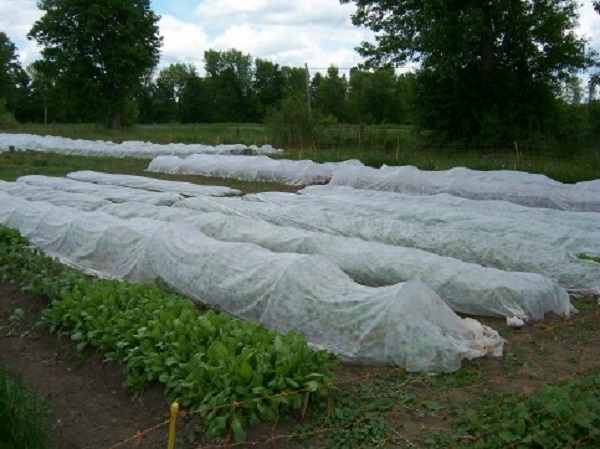
Floating row covers are handy items for any gardener or grower in any climate. A floating row cover is a lightweight, spunbonded white fabric made of either polyester or polypropylene. It is most often used to protect plants from a light frost, but it has uses for gardeners in warmer climates too.
When a light frost is expected in either spring or fall, floating row cover fabric can be draped over plants to help hold in warmth from the ground, protecting your plants from freezing. A lightweight row cover will give 2-4 degrees of temperature protection for your plants, while heavier row covers will provide frost protection in temperatures as low as 20 degrees. Used in the spring, row covers allow you to start your garden up to two weeks early.
Sunlight and rain will both pass through the floating row cover to your plants, so the fabric can be left on the plants as needed. The fabric is so lightweight that any breeze will send it drifting away if it isn’t anchored down so secure the edges to the ground with rocks, piles of soil, or wire earth staples. Earth staples are simply U-shaped wires that are pushed through the fabric and into the soil to hold the fabric down.
Floating row covers make good barriers against hungry animals and insects. Foil the neighborhood rabbits by draping floating row cover over young plants until the plants are a bit older and not as desirable for bunny lunches. Floating row covers can also prevent insects from attacking your plants. This is particularly useful for vegetable crops such as broccoli or squash. If the butterflies can’t lay their eggs on your crop you won’t have any little green worms hiding amongst the broccoli florets. Similarly, squash bugs can’t reach squash plants that are hiding under a floating row cover. But make sure to remove the fabric from the plants when they begin to flower so pollinating insects can reach the blossoms.
Floating row covers are available in garden centers, gardening catalogs and online. The fabric comes in a variety of widths and lengths, and can be purchased in lengths long enough to cover an entire row of plants. If used and stored carefully, the fabric can last for several years.
Mike McGroarty is the owner of McGroarty Enterprises and the author of several books. You can visit his website at Freeplants.com and read his blog at Mikesbackyardnursery.com.
Related Articles & Free Email Newsletter Sign Up
How to Build a Simple Potting Bench
How to Prepare a Weed Free Raised Planting Bed




Comment here